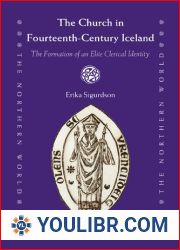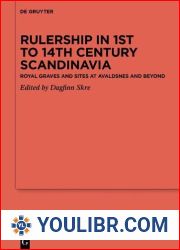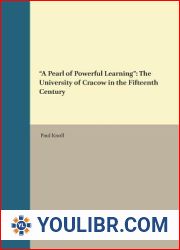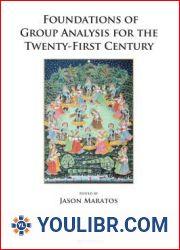
BOOKS - The Church in Fourteenth-Century Iceland: The Formation of an Elite Clerical ...

The Church in Fourteenth-Century Iceland: The Formation of an Elite Clerical Identity
Author: Erika Sigurdson
Year: September 14, 2015
Format: PDF
File size: PDF 1.4 MB
Language: English

Year: September 14, 2015
Format: PDF
File size: PDF 1.4 MB
Language: English

The Church in FourteenthCentury Iceland: The Formation of an Elite Clerical Identity In "The Church in FourteenthCentury Iceland Erika Sigurdson provides an in-depth examination of the evolution of the Icelandic Church during the fourteenth century, focusing on the emergence of an elite clerical identity that played a crucial role in shaping the religious and social landscape of the island nation. This period saw significant changes within the Church, including the implementation of ecclesiastical reforms initiated by the Catholic Church in the late thirteenth century. These reforms aimed to strengthen the authority of the Church and promote a more centralized governance structure, which had a profound impact on the formation of an elite clerical class. The book explores how this new elite clerical identity was formed and solidified over time, and how it influenced the religious practices and beliefs of the common people. Through a meticulous analysis of historical records and texts, Sigurdson reveals how the Church's emphasis on education, liturgy, and ritual contributed to the development of a distinct Icelandic spiritual tradition that differentiated itself from mainland Europe.
Церковь в Исландии XIV века: Формирование элитной клерикальной идентичности в «Церковь в Исландии четырнадцатого века» Эрика Сигурдсон подробно исследует эволюцию исландской церкви в течение четырнадцатого века, уделяя особое внимание появлению элитной клерикальной идентичности, которая сыграла решающую роль в формировании религиозного и социального ландшафта островного государства. В этот период произошли значительные изменения внутри Церкви, включая проведение церковных реформ, начатых Католической церковью в конце тринадцатого века. Эти реформы были направлены на укрепление авторитета Церкви и продвижение более централизованной структуры управления, что оказало глубокое влияние на формирование элитарного клерикального класса. Книга исследует, как эта новая элитарная клерикальная идентичность формировалась и укреплялась с течением времени, и как она влияла на религиозные практики и убеждения простого народа. Посредством тщательного анализа исторических записей и текстов Сигурдсон показывает, как акцент Церкви на образовании, литургии и ритуале способствовал развитию отдельной исландской духовной традиции, которая отличалась от континентальной Европы.
L'Église en Islande du XIVe siècle : La formation d'une identité clérique d'élite dans « L'Église en Islande du XIVe siècle » d'Erika gurdson explore en détail l'évolution de l'Église islandaise au cours du XIVe siècle, en se concentrant sur l'émergence d'une identité clérique d'élite qui a joué un rôle décisif dans la formation du paysage religieux et social de l'État insulaire. Au cours de cette période, des changements importants ont eu lieu au sein de l'Église, y compris la mise en œuvre des réformes ecclésiastiques lancées par l'Église catholique à la fin du treizième siècle. Ces réformes visaient à renforcer l'autorité de l'Église et à promouvoir une structure de gouvernance plus centralisée, ce qui a eu un impact profond sur la formation d'une classe cléricale élitiste. livre explore comment cette nouvelle identité cléricale élitiste s'est formée et renforcée au fil du temps, et comment elle a influencé les pratiques religieuses et les croyances du peuple ordinaire. Par une analyse minutieuse des documents et des textes historiques, gurdson montre comment l'accent mis par l'Église sur l'éducation, la liturgie et le rituel a contribué au développement d'une tradition spirituelle islandaise distincte qui était différente de l'Europe continentale.
La Iglesia en Islandia del siglo XIV: La formación de una identidad clerical de élite en la «Iglesia en Islandia del siglo XIV» Erika gurdson explora en detalle la evolución de la Iglesia islandesa durante el siglo XIV, prestando especial atención al surgimiento de una identidad clerical de élite que jugó un papel crucial en la formación religiosa y social el paisaje del estado insular Durante este período hubo cambios significativos dentro de la Iglesia, incluyendo la implementación de reformas eclesiásticas iniciadas por la Iglesia católica a finales del siglo XIII. Estas reformas tenían como objetivo fortalecer la autoridad de la Iglesia y promover una estructura de gobierno más centralizada, lo que tuvo un profundo impacto en la formación de una clase clerical elitista. libro explora cómo esta nueva identidad clerical elitista se formó y fortaleció con el paso del tiempo, y cómo influyó en las prácticas y creencias religiosas de la gente común. A través de un cuidadoso análisis de los registros históricos y los textos, gurdson muestra cómo el énfasis de la Iglesia en la educación, la liturgia y el ritual contribuyó al desarrollo de una tradición espiritual islandesa separada que era diferente de la continental.
Chiesa nell'Islanda del XIV secolo: La formazione di un'identità clericale elitaria in «Chiesa nell'Islanda del Quattordicesimo secolo» di Erik gurdson esplora in dettaglio l'evoluzione della chiesa islandese nel quattordicesimo secolo, con particolare attenzione alla nascita di un'identità clericale elitaria che ha avuto un ruolo cruciale nella formazione del panorama religioso e sociale dello Stato insulare. In questo periodo ci sono stati notevoli cambiamenti all'interno della Chiesa, tra cui l'attuazione delle riforme ecclesiastiche avviate dalla Chiesa Cattolica alla fine del Tredicesimo secolo. Queste riforme miravano a rafforzare la credibilità della Chiesa e a promuovere una struttura di governo più centralizzata, con un profondo impatto sulla formazione di una classe clericale elitaria. Il libro indaga come questa nuova identità clericale elitaria si è formata e rafforzata nel corso del tempo, e come ha influenzato le pratiche religiose e le convinzioni del popolo comune. Attraverso un'attenta analisi dei registri storici e dei testi, gurdson mostra come l'enfasi della Chiesa sull'educazione, la liturgia e il rituale ha contribuito allo sviluppo di una tradizione spirituale islandese separata dall'continentale.
Kirche im Island des 14. Jahrhunderts: Bildung einer klerikalen Elite-Identität in „Kirche im Island des 14. Jahrhunderts“ Erika gurdson untersucht ausführlich die Entwicklung der isländischen Kirche im 14. Jahrhundert und konzentriert sich auf die Entstehung einer klerikalen Elite-Identität, die eine entscheidende Rolle bei der Gestaltung der religiösen und sozialen Landschaft des Inselstaates spielte. In dieser Zeit gab es bedeutende Veränderungen innerhalb der Kirche, einschließlich der Durchführung von Kirchenreformen, die von der katholischen Kirche am Ende des dreizehnten Jahrhunderts eingeleitet wurden. Diese Reformen zielten darauf ab, die Autorität der Kirche zu stärken und eine zentralisiertere Verwaltungsstruktur zu fördern, was einen tiefgreifenden Einfluss auf die Bildung einer elitären klerikalen Klasse hatte. Das Buch untersucht, wie diese neue elitäre klerikale Identität im Laufe der Zeit geformt und gestärkt wurde und wie sie die religiösen Praktiken und Überzeugungen des einfachen Volkes beeinflusste. Durch eine sorgfältige Analyse der historischen Aufzeichnungen und Texte zeigt gurdson, wie die Betonung der Kirche auf Bildung, Liturgie und Ritual zur Entwicklung einer separaten isländischen spirituellen Tradition beitrug, die sich von Kontinentaleuropa unterschied.
''
14. yüzyılda İzlanda'da Kilise: Erika gurdson'un "On Dördüncü Yüzyılda İzlanda Kilisesi'nde Elit Bir Dini Kimliğin Oluşumu", on dördüncü yüzyılda İzlanda kilisesinin evrimini ayrıntılı olarak inceleyerek, ada ülkesinin dini ve sosyal manzarasını şekillendirmede çok önemli olan seçkin bir dini kimliğin ortaya çıkmasına odaklanıyor. Bu dönem, on üçüncü yüzyılın sonlarında Katolik Kilisesi tarafından başlatılan kilise reformlarının uygulanması da dahil olmak üzere Kilise içinde önemli değişiklikler gördü. Bu reformlar, Kilise'nin otoritesini güçlendirmeyi ve elitist bir dini sınıfın oluşumu üzerinde derin bir etkisi olan daha merkezi bir yönetim yapısını teşvik etmeyi amaçlıyordu. Kitap, bu yeni elitist dini kimliğin zaman içinde nasıl şekillendiğini ve sağlamlaştığını ve sıradan insanların dini uygulamalarını ve inançlarını nasıl etkilediğini araştırıyor. Tarihsel kayıtların ve metinlerin dikkatli bir şekilde analiz edilmesiyle gurdson, Kilisenin eğitim, ayin ve ritüele verdiği önemin, kıta Avrupa'sından farklı olan ayrı bir İzlanda manevi geleneğinin gelişimine nasıl katkıda bulunduğunu göstermektedir.








 49
49  2 TON
2 TON































